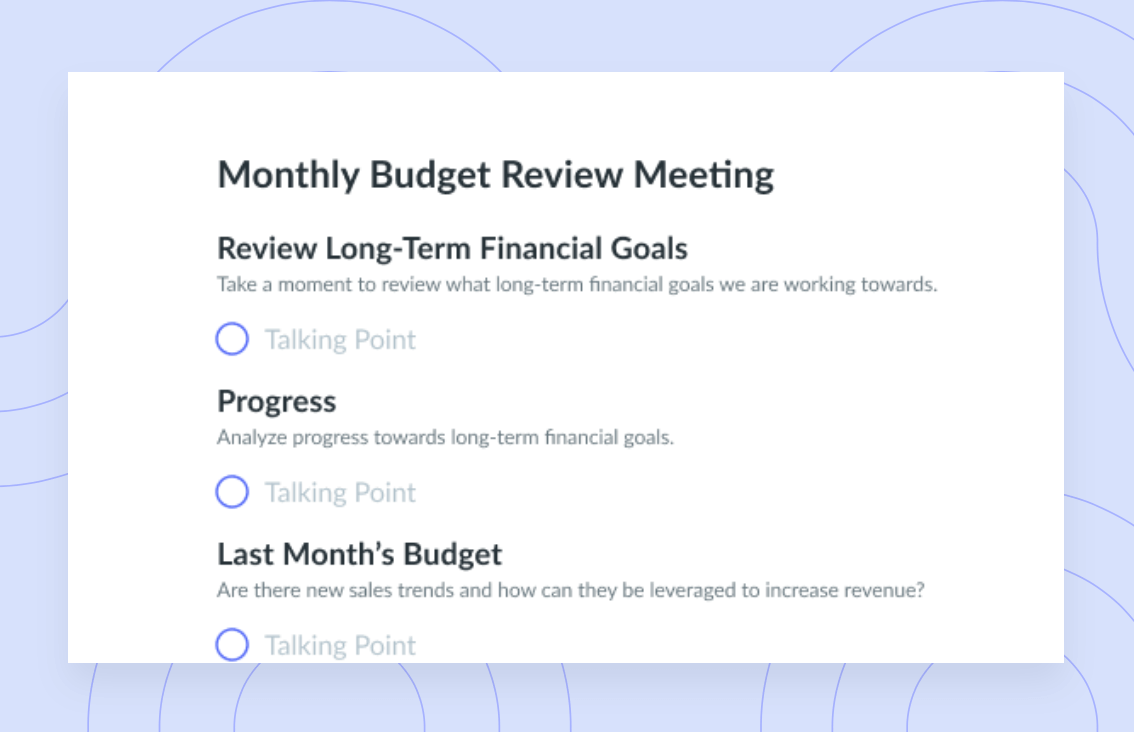
Performance Improvement Plan (PIP) Meeting Template
Get this templateUse this template inspired by the University of Central Arkansas to identify critical areas of concern, performance gaps, and expectations, as well as to demonstrate improvement and commitment.




Performance Improvement Meeting Overview
A performance improvement plan, also known as a performance action plan, is a tool used by employers to provide employees who struggle with performance, with a concrete plan with the opportunity to succeed. Employers can use a PIP meeting to discuss the failure to meet specific job-related goals or to communicate behaviour concerns.
It’s typical for employers to request that a meeting be held every 2 weeks or so, while the PIP plan is in action. For most performance improvement plan meetings, the employee should expect to meet with both their supervisor and a member of the Human Resources team. It’s not uncommon for employers to hold PIP meetings with a supervisor only, but regarding HR concerns, a team member should be present.
A performance improvement meeting does not indicate termination. Instead, these meetings are essential to keep employers and employees on the same page. PIP plans provide ample opportunity and guidance for employees to understand and therefore perform better within their titles.
While it can be challenging on both ends to avoid a defensive approach, employers should encourage employees to maintain a positive attitude, ask questions, ask for more time to complete tasks when necessary, set goals, check in regularly, and never hesitate to ask for help. Communication is vital.
How to Run an Effective Performance Improvement Plan Meeting
“The true measure of the value of any business leader and manager is performance.” – Brian Tracy
There is one thing that all PIP meetings require other than effective communication of expectations, and that is preparedness. Running a PIP meeting without hiccups means preparing well in advance to present the employee with expectations and highlight shortcomings without coming off as condescending or disappointed.
Employers’ goals within a PIP meeting should be to open up a dialogue with the employee before anything else, expressing concerns but also attempting to find the root cause of whatever issues need addressing. It is crucial to set achievable goals. While we want to improve employee performance, we also want to ensure that we begin with goals that are attainable when the employee focuses on actionable improvements.
Providing positive guidance and the resources needed to embrace job improvement is essential. It may be required to invest in additional training and time to get the employee where they need to be performance-wise, and employers should be prepared to provide this.
A PIP meeting template is a fantastic way to prepare for a performance improvement plan meeting. Not only can employers organize their own thoughts regarding the situation, but they can outline employee expectations and keep their train of thought moving in the right direction in the case of a derailment.
What’s inside this PIP Meeting Template:
1 ❓Areas of concern
It’s crucial for employers to outline the areas of concern in as much detail on the template as possible. This ensures that nothing is forgotten in the face-to-face meeting with the employee. Write down the main issue, and maybe a few ways that issue presents itself in other aspects of the job.
2 💡 Observations and notes from previous discussions
To remain on the same page and move forward in a progressive manner, employers should take notes from previous PIP meetings and highlight what they believe is important to bring to the table again. Observations are important too, such as the employee saying one thing in a PIP meeting, but consistently doing another when on the job.
3 🚀 Improvement goals
If employers are not presenting improvement goals, then there isn’t a point to the PIP meeting. A performance improvement plan meeting is not to bombard employees with everything they’re doing wrong, but instead, to provide them with goals that highlight how they can do their job right. Setting goals gives them something to work toward, and perhaps a better understanding of employer expectations.
4 ⚽ Activity goals
Employers should expect to see an uptick in activity regarding the employee presented with a PIP. It’s important to understand all circumstances, and accurately describe the current problem and the expected goal in detail. While improvement goals focus on overall improvement, activity goals should focus on smaller, job detail-related goals.
5📚 Resources
Employers must provide employees with the correct resources to help them succeed. Whether this is additional training or an open-door policy when it comes to asking questions, people cannot typically show much improvement when denied the proper tools. The resources will likely differ a bit for each PIP meeting.
6💪 Management support
Along with resources comes management support. In this section, employers should get specific regarding how they plan to help the employee that requires the PIP. It’s vital to highlight that management is available for support at any time, and with any performance issue that might pop up.
7❗Expectations
As the meeting draws to a close, go over employee expectations once again. This section will help everyone in the meeting end on the same page concerning how to move forward. Expectations should be clear, and this is a great place to provide time for the employee to ask any questions they’ve got.
8✔️ Progress checkpoints
When actively engaged in a PIP, employee progress has to be monitored. This includes creating progress checkpoints and scheduling additional meetings in the future. In general, it’s a good rule to hold progress checkpoints every two weeks, as to not overwhelm with meetings but to stay on track performance-wise.
















